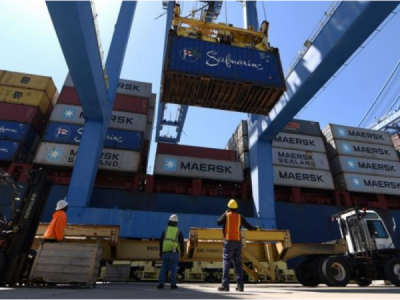
Posted on April 1, 2019
Officials say project’s economic value outweighs environmental concerns
WILMINGTON — The economic value of expanding the Port of Wilmington’s turning basin should outweigh environmental concerns, the N.C. State Ports Authority has argued in a variance request.
“Arguably this area has no social or aesthetic values and has severely diminished natural characteristics. However, it does have great economic values to the economy of North Carolina,” states the Ports Authority’s request for the project in the Cape Fear River just south of the Cape Fear Memorial Bridge.
Ports officials are seeking to expand the turning basin from 1,400 feet to 1,524 feet, dredging 42 feet down with an additional 3 feet of depth for maintenance. The N.C. Division of Coastal Management (DCM) denied the Ports Authority’s request for a Coastal Area Management Act (CAMA) permit, in part by citing state rules about managing estuarine waters and preserving wetlands as a cultural resource.
Widening the turning basin is necessary, the authority argued, so Wilmington would be able to receive vessels carrying 14,000 shipping containers — an advancement they believe is vital to the port’s future.
“If the turning basin is not expanded, those vessels will bypass the (Port of Wilmington) and call on other east coast ports, thereby causing significant economic impact to the (Port of Wilmington) and the North Carolina economy,” the application states, adding ports in New York City, Norfolk and Savannah are or will soon be able to accept the ships.
The Ports Authority’s variance request could be heard as soon as the CRC’s April meeting. If the proposal advanced, it would result in the dredging of 17.76 acres of primary nursery area habitat and the excavation of about an acre of coastal wetland.
Concerns raised by organizations such as the N.C. Coastal Federation about the port’s plan include the environmental impact of dredging within a primary nursery area, which is defined as an area where young finfish and crustaceans develop. Similar concerns were raised by the N.C. Division of Marine Fisheries.
In a March 19 letter denying the request, DCM Director Braxton Davis wrote a state statute requires denial “for cases where a proposed development will have significant adverse impact to fisheries resources.”
For the Ports Authority to receive the variance from the CRC, it must convince commissioners that strict application of the state’s rules is causing unnecessary hardship, that the hardship results from “conditions peculiar” to the Ports Authority property, and that the hardship doesn’t result from actions taken by the petitioner.
While the primary nursery area extends from bank to bank in the vicinity of the turning basin, the ports maintains that dredging since 1945 has diminished the value of fisheries in the area.
“There is no submerged aquatic vegetation, shellfish, or hard bottom habitat located within the proposed action area,” the variance request states.
Additionally, the variance request states the project would include mechanical dredging, turbidity curtains and other steps to reduce the dredging’s environmental impact. The authority also intends to wait until after July 1, 2019, to start construction to avoid impacting fish migrating up the Cape Fear to spawn.
Balancing competing interests
In addition to the CAMA permit, the project also needs an Army Corps of Engineers permit and certification from the N.C. Division of Water Resources (DWR). The state permit is on hold while the Ports Authority and DWR staff continue negotiating mitigation activities.
Tracy Skrabal, a coastal scientist in the Coastal Federation’s Wilmington office, said, “The question that really needs to be asked is if — in the balancing of economic interest with the port operations and this obvious impact to primary nursery areas as well as wetlands resources — have they done due diligence in regards to avoiding any impacts they could, mitigating impacts that were unavoidable and providing a thoughtful and hopefully successful mitigation plan?”
Mitigation efforts included in the variance request include the creation of a conservation easement on 30.2 acres of wetlands and tidal marsh east of the Brunswick River; creating tidal pools on 6.75 acres on the Brunswick River; donating $800,000 to upgrade a fish passage at Lock and Dam #1 on the Cape Fear River in Bladen County; and enhancing 1.75 acres of tidal marsh on the port’s property.
“Allowing the variance will preserve justice by avoiding the loss of reasonably made and lawful investment in the existing port facilities and the development of this aspect of the North Carolina economy,” the variance states. “The mitigation measures will protect the public interest in public natural resources.”
Source: starnewsonline.com





